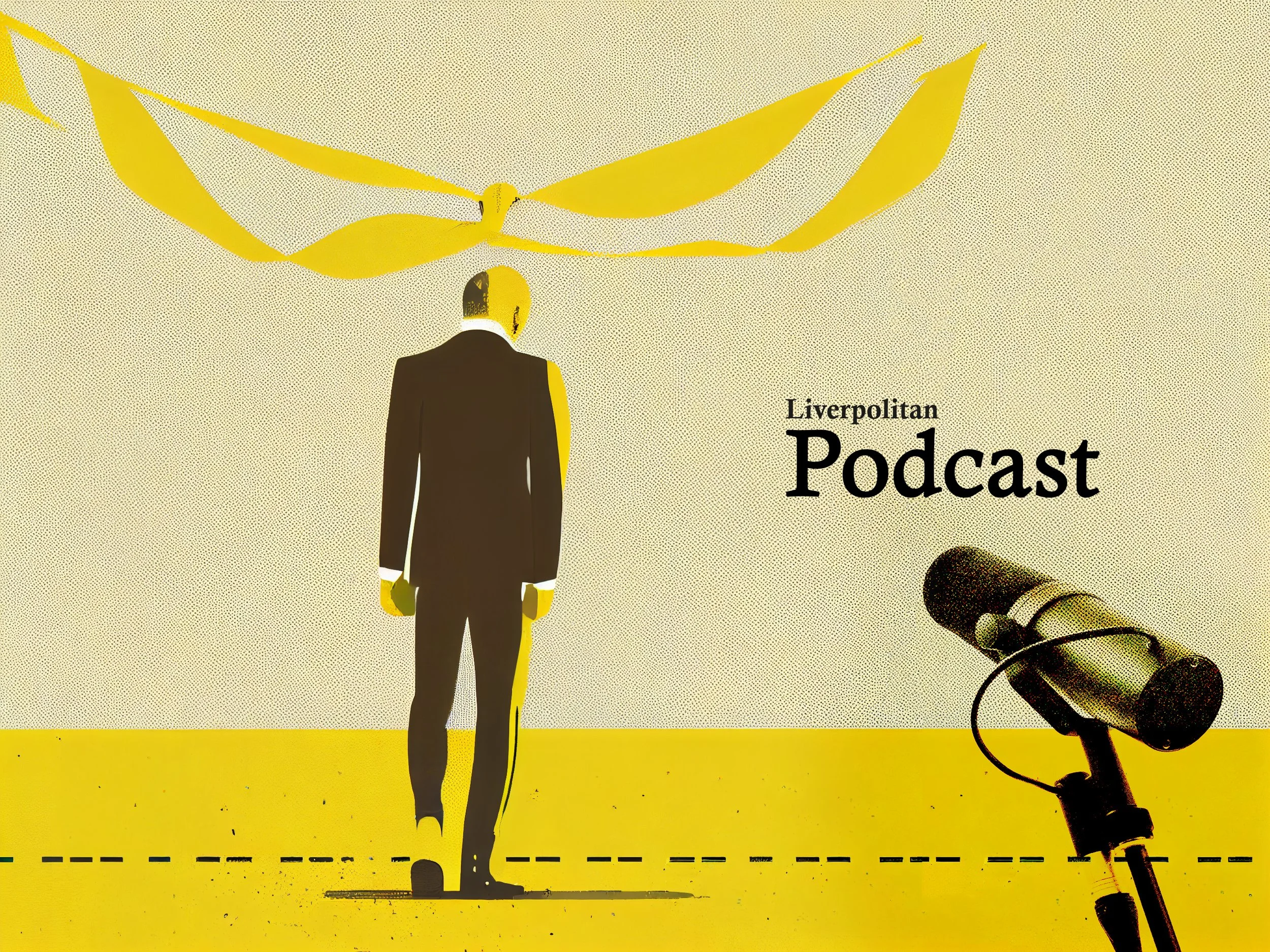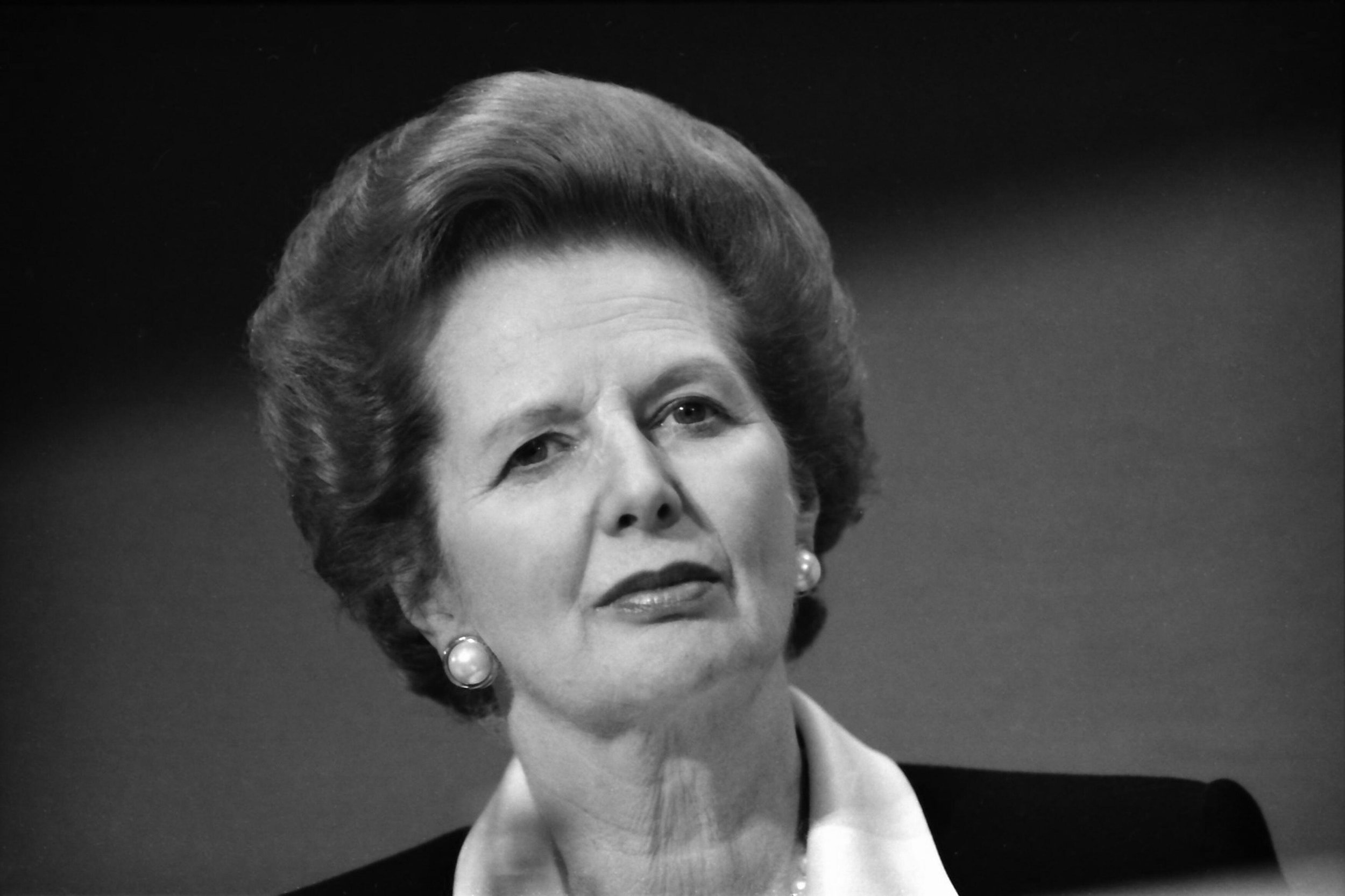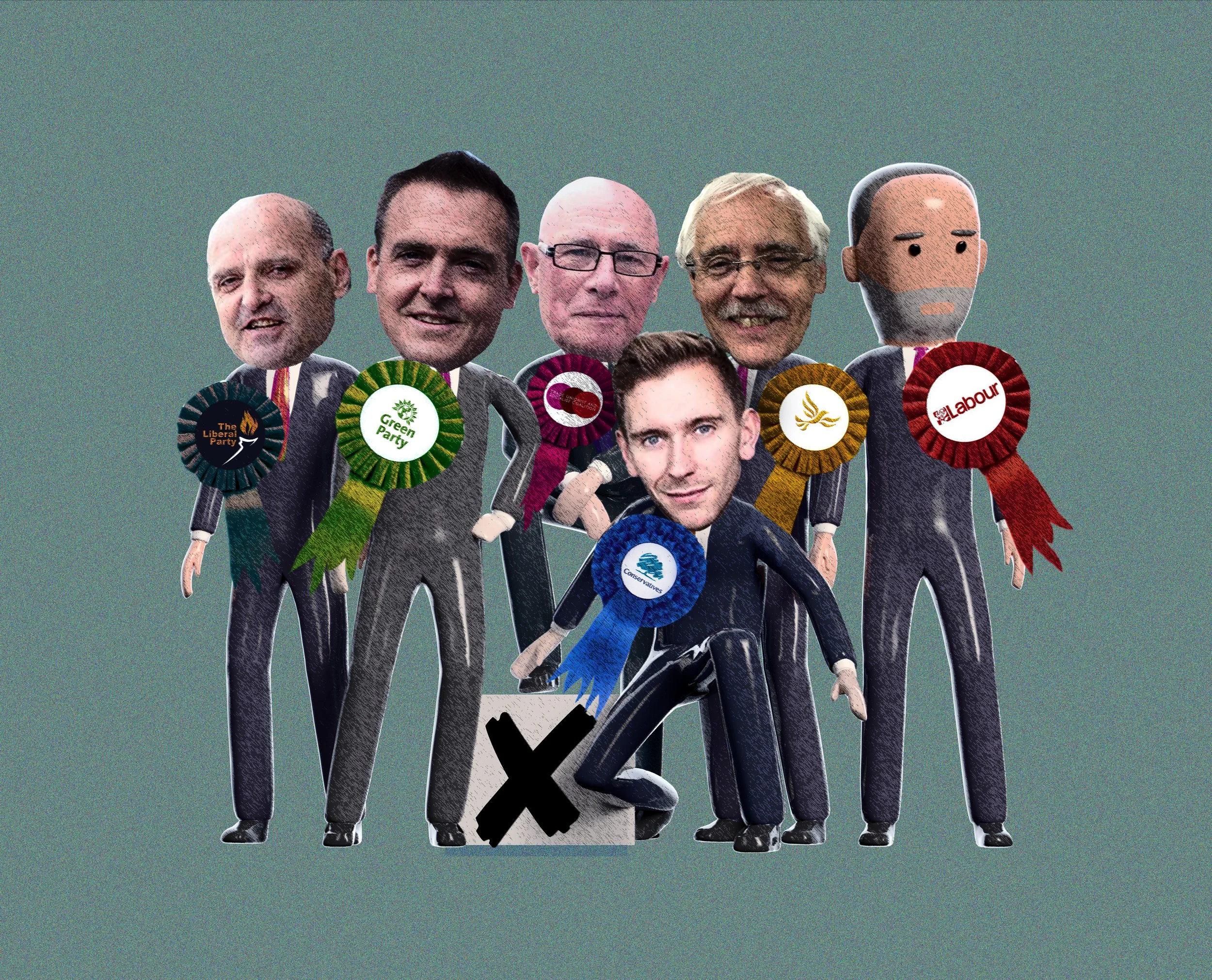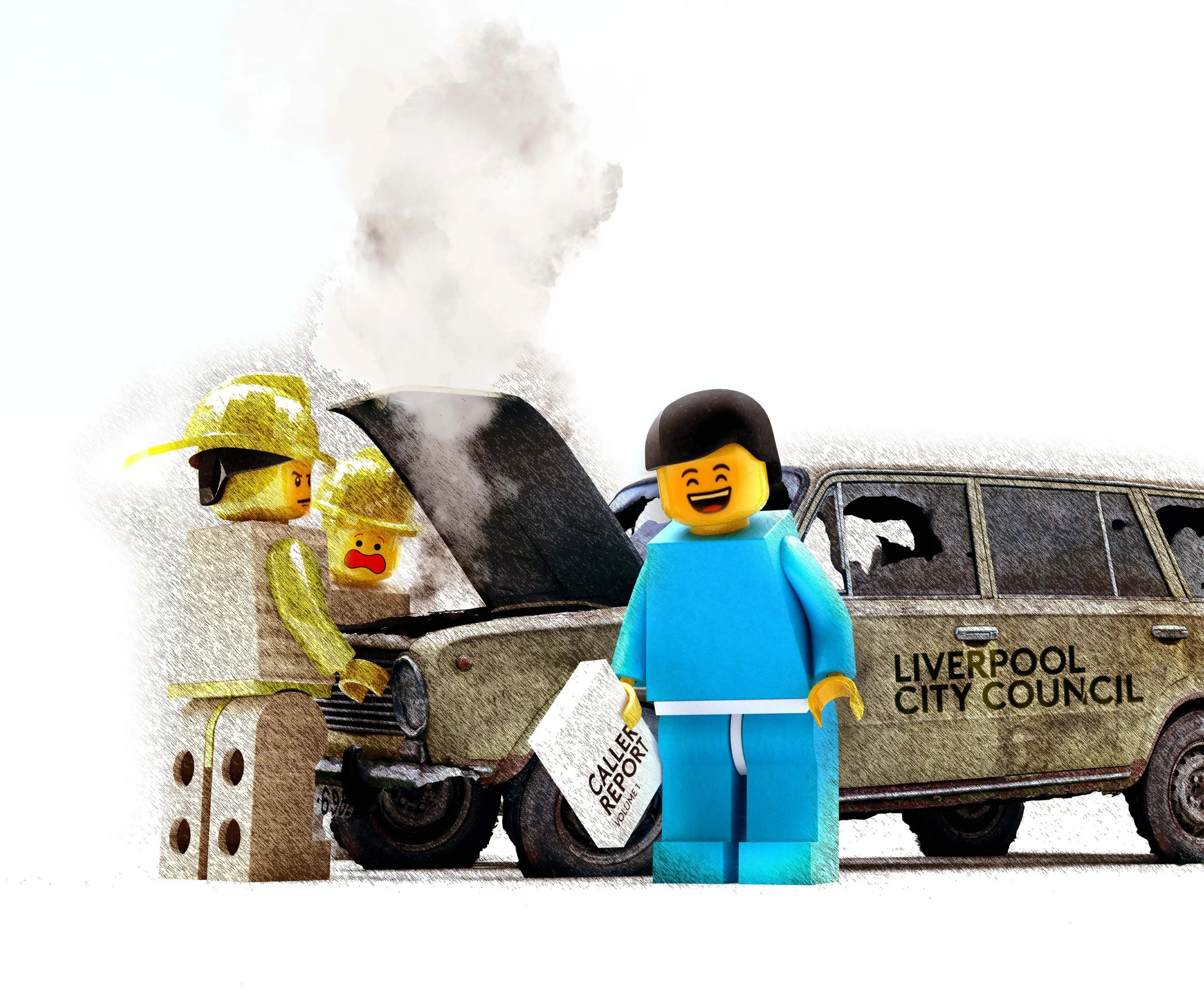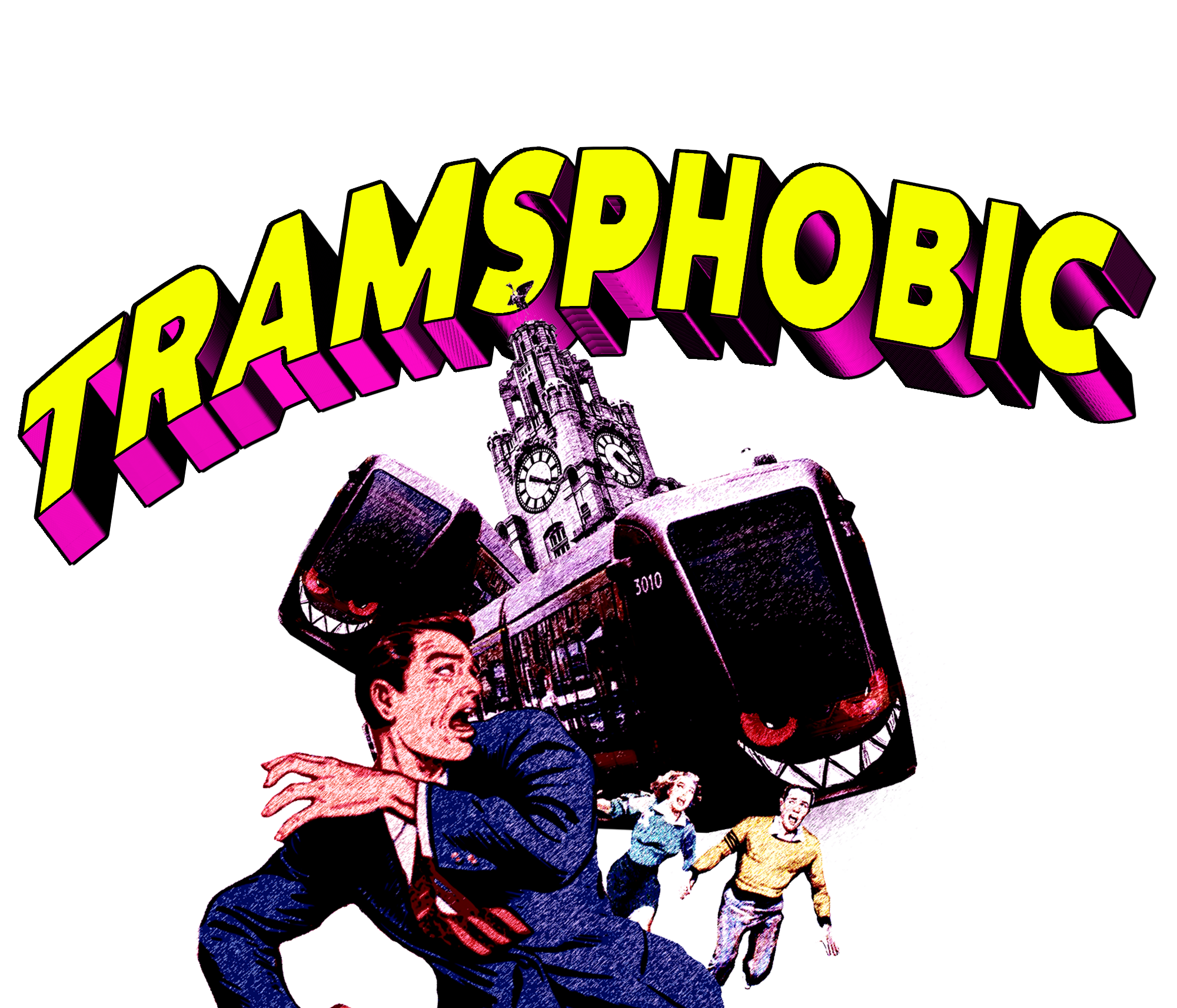Recent features
Trams-phobia. Time to face our fear of light rail
The embarrassing history of Liverpool’s abortive Merseytram project put the fear of God into city leaders, rendering any discussion of light rail a taboo subject never to be whispered in the corridors of power. It’s a sorry tale with many twists and turns, but is it time to get over it? Could trams still offer a solution to the city’s transport blackspots?
Prof. Lewis Lesley
Liverpool’s status at the point of embarkation for the first inter-city train journey is well acknowledged and celebrated, but it’s also the case that our city region (or Birkenhead to be more precise) was the location for Britain’s first ever urban tramway in 1860.
Trams continued to be a major means of transit and connectivity across the City Region until the late 1950s. The rise of personalised motor vehicles and the desire of drivers for unimpeded priority over cumbersome fixed-track trams, led to their gradual replacement by diesel buses across the UK and many other countries.
In recent decades there has of course been a growing awareness that ever increasing car use has presented its own set of problems including poor air quality, congestion, fatalities and injuries arising from crashes, not to mention the motor vehicle’s not inconsiderable contribution to global warming. The desire to rebalance cities, reduce congestion and pollution and prioritise sustainable transport modes, has led to a major renewal of interest in trams as a key component in cleaner and more efficient urban transit. Today, Manchester, Sheffield, Birmingham, Nottingham, Edinburgh and Bristol are amongst the cities that either have or are planning to introduce integrated tram networks as part of their urban transport system.
So why not Liverpool? Light Rail systems (trams on tracks) are not only not under active consideration, but they have become a taboo subject never to be whispered in the corridors of power. Why is this the case, and shouldn’t proper consideration be given to the contribution that trams could make to addressing some of our most acute transport and environmental policy challenges?
Let me start by declaring an interest. I am not only an expert advocate for trams, but I played a key role in promoting a tram system for Liverpool between the city centre and John Lennon Airport in the 1990s. The project had a number of notable and attractive features; lightweight trams and track would have been a less intrusive and costly option to the system then being installed with great fanfare in Manchester. But perhaps its most significant component, at least as far as the public decision-makers were concerned was that it was to be delivered and financed entirely by the consortium's lead partner, PowerGen.
The repercussions of the Merseytram fiasco were enough to make trams a toxic subject and a trauma that no local politician ever wanted to revisit.
Private investment in Liverpool has, alas, never been an uncontentious or universally welcomed proposition. The idea that a private company should physically install as well as operate a modern transport system was perhaps ahead of its time, and considered something of an affront to the teams at Merseytravel and Liverpool City Council. Their preferred option was something called the Merseyside Rapid Transit System - effectively guided buses - which was ultimately thrown out by the Secretary of State for Transport. Despite its comparative drawbacks, its status as an approved Merseytravel scheme ensured that our consortium's proposals received less than perfunctory consideration and planning permission was refused. Unlike trams that operate on dedicated track, MRTS would have operated on existing roads, competing for space and priority with other road users. Without dedicated road space and right of way priority even the modern incarnation of "trackless trams," with their sleek train-like appearance - designed to overcome the "trams are sexy, buses are boring perception" - are a poor second best solution. Steel traction always provides a better ride and passenger experience than rubber on tarmac.
Some years passed. By 2005, even Merseytravel had embraced the tram concept.
Fig 1: Merseytram’s proposed 3-line network
A three line network was proposed with routes from Liverpool city centre to Kirkby, Prescot and Whiston and the airport. But the project was doomed to failure and it’s a sorry tale with many twists and turns. Project costs spiralled amid delays, accusations of poor value for money, arguments over which routes should be prioritised, as well as reported management failures at Merseytravel as outlined in a damning 53-page report by District Auditor, Judy Tench.
Relationships between the transport authority and councils, who were responsible for providing a not insignificant chunk of the now £325m budget for Line One, proved challenging and buy-in was never firmly established. Merseytravel spent £70m on consultancy fees, land acquisition, design, initial engineering and steel for the tracks without ever getting final sign-off from the Treasury. The government watched on as Merseytram morphed from a transport project into a local political football.
Senior management at Merseytravel blamed “rogue officials” at the City Council such as CEO David Henshaw for undermining the project, claiming he was leaking information to the Department for Transport, which chipped away at the government’s confidence. The City Council saw it another way believing the project was an impertinent and poorly managed imposition on their turf by Merseytravel. In the face of political rows, planning wrangles and the absence of unequivocal local political support, the government’s patience wore out. Despite being granted full planning approval at a Public Inquiry, the prospect of ongoing squabbles between the City Council and Merseytravel, ultimately resulted in the withdrawal of funding by the then Transport Minister, Sadiq Khan.
Merseytravel spent £70m on consultancy fees, land acquisition, design, engineering and steel without ever getting final sign-off from the Treasury. Merseytram had morphed from a transport project into a local political football.
Interestingly, the decision to prioritise the Kirkby route over the more obviously strategic and commercially viable route to Liverpool airport, was one of the reasons why Merseytram lost the crucial support of the City Council in the first place. The Kirkby route scored higher in terms of regeneration and social value attracting higher capital grant support from central government but it came at greater financial risk to the local authorities and they were reluctant to jump in. In the end, the only thing the city had to show for it was substantial debts, embarrassed red faces, and a stack of unnecessary compulsory purchase orders on private property. Sadly, the repercussions of the Merseytram fiasco, including the selling off of the unused steel rails for a third of their original purchase price was enough to make trams a toxic subject and a trauma that no local politician ever wanted to revisit.
In the intervening years, trams have been introduced into other major cities with great success and growing public popularity. Yet Liverpool, burned by its past experiences, has shied away from taking a fresh look at the subject and has avoided initiating any kind of study or research to evaluate the potential benefits or contribution of light rail to the region’s future transport needs.
But can we really allow political embarrassment to preclude consideration of a transport option that in 2005 was recognised as an inherently good idea? As late as 2012 Liverpool Vision’s Strategic Investment Framework (SIF) embraced the need for a direct rapid transit link to Liverpool Airport, which was once again addressed in our 2015 Trampower proposal.
So what are the potential benefits of a tram system for Liverpool City Region and how might it help us to solve some of our most pressing policy challenges?
1. Trams are clean and green
During the first Covid lockdown, reductions in car traffic realised an enormous and immediate improvement in air quality, but car use is now already back to pre-Covid levels, whilst public transport patronage is only at half its former level. Transport is the main source of toxic air pollution and in a city where more than 60% of all journeys are by car, motor vehicles bear a massive responsibility for the estimated 1,040 annual deaths in the city region arising from bronchial and cardio illnesses attributable to poor air quality. Reducing car use and promoting modal shift towards public transport would make a substantive contribution to improving air quality and ensuring fewer illnesses and deaths.
Similarly, cars are a huge source of CO2 emissions locally and globally. The recent COP26 summit in Glasgow drew up plans to reduce greenhouse gas emissions to zero by 2050 to avert the worst consequences of global warming. Liverpool City Region has adopted an ambitious Climate Action Plan and aims to be carbon neutral before 2040. This will necessitate a comprehensive reappraisal of transport policies, beyond its current rail investment and bus re-regulation plans, to achieve modal shift and reduce private car use. Whilst electric cars produce no CO2 they do create carcinogenic micro particles from tyres and tarmac. Meanwhile, the effectiveness of their contribution to CO2 reduction depends significantly on how quickly people make the switch from diesel and petrol, which in turn will be influenced by the availability of charging points. So, notwithstanding the environmental benefit of electric cars, they are not going to provide the magic bullet. Promoting modal shift where possible to reduce congestion and pollution should encompass consideration of sustainable transport modes, including trams.
2. People like trams
Where trams have been introduced in other UK cities they have resulted in a significant shift from private car use to public transport with roughly a quarter of users attracted away from their cars. According to a study by the Passenger Transport Executive Group it was estimated that the first wave of tram systems in the UK led to an annual reduction of 22 million car journeys, with more recent studies suggesting this figure is now nearer to 60 million.
Trams are reliable, they run to predictable timetables and are three times more energy efficient than buses. There is also significant evidence that they are perceived as more modern, aspirational and attractive to commuters who would be unwilling to switch to buses. The introduction of the Luas tram system in Dublin was instrumental in ensuring that two thirds of all journeys into the city centre are now via public transport, compared to only a quarter in Liverpool. Attitudinal studies in Dublin revealed that many tram users from the more affluent suburbs would never contemplate bus use.
A Department for Transport Survey in 2019 showed that tram passengers gave a 90% approval rating, because trams are 90% reliable, as well as 73% always finding space and 70% agreeing tram fares are good value for money.
3. Trams make quicker connections between neighbourhoods and centres of employment
As recognised by the 2015 Liverpool Vision SIF a direct rapid transport link to
Liverpool John Lennon Airport remains a fundamental necessity. We are one of the few UK or major international cities without such a link, and extending the rail connection from South Parkway is neither practicable in terms of land availability nor affordable. Trampower has demonstrated the viability and affordability of a tram link to John Lennon Airport which would also serve key retail and employment sites as well as residential neighbourhoods not currently served by Merseyrail. The detailed scoping and feasibility work undertaken by Trampower envisaged a tram every six minutes, and a journey between the airport and city centre taking about half an hour, with a high level of reliability thanks to traffic-free tram reservations for nearly half the route, and ‘green wave’ priority traffic management for the rest.
Trams and streetcars have also been mooted as a means of improving connectivity to emerging, but currently disconnected employment areas like Liverpool’s Knowledge Quarter and Wirral Waters. Whether these are stand-alone solutions or part of an integrated city region network, the proposals acknowledge the value and popularity of trams as a means of getting large numbers of people from A to B within a dynamic urban environment. With one line operational, additional lines can be added on a marginal cost basis, so strengthening otherwise weak financial cases.
4. Trams are more affordable and cost effective
Whereas extending Merseyrail from South Parkway to the airport may seem like a preferable option, for the volume of passengers involved, it would simply be uneconomic. Despite the Chancellor’s substantial, recent £710m transport grant to the Metro Mayor, there is limited scope to significantly extend metro rail infrastructure across the city region due to its intrinsic cost. As one senior transport practitioner observed, trams cost 10% of a metro rail system and deliver 90% of the benefits. So a tramway could therefore be a cost effective solution, and serve communities along the route very well. Focusing on the priority route to Liverpool Airport, Trampower identified at least 60 possible routes and combinations, many following old tram lines which utilised the central reservations of boulevards in the south of the city. In addition, there is already space allocated at the Liverpool One bus terminus for trams dating from the failed Merseytram project.
Combining lighter, newer CityClass Mk2 trams with a low profile “no dig – glue in the road” track system would further reduce the cost and time of installation in streets, and provide work for British Steel to roll LR55 rails, saving on imports. LR55 has been in use in Sheffield for over 25 years without needing any maintenance.
5. Trams deliver investment and regeneration
Trams bring investor confidence, as demonstrated in Croydon, Manchester, Nottingham and wherever they have been installed. This means that development is attracted to locations close to tramways, benefiting from the improved quality of service offered with enhanced accessibility and reliability. Research published by Lloyds Bank looking at the effect of tram systems in Manchester, Birmingham and Edinburgh revealed that house prices rose by 12% compared to average rises in unserved parts of those cities. More generally, trams are seen as a visible sign of investment, ambition and modernity, boosting civic pride and confidence and helping to attract tourism. Manchester’s civic leaders have cited the Metrolink tram system as one of the pivotal investments that transformed perceptions of the city.
In conclusion, trams are clean, green, efficient and affordable. They deliver outputs that are hard to replicate through comparable investment in rail or bus. It’s not the purpose of this article to insist our city region embraces the tram now, but we should be willing to put it in the mix and to evaluate their potential contribution to meeting future transport, regeneration and environmental challenges. It's time for our Metro Mayor to signal a new era, and a willingness to consider ideas and proposals emanating from outside the closed circle of public sector policy makers - still seemingly traumatised by the Merseytram experience. It's time to take another look at trams.
Professor Lewis Lesley is an acknowledged expert in urban public transport. Formerly Professor of Transport Science at Liverpool John Moores University, he is also the author of the Light Rail Developers’ Handbook. As Technical Director at Trampower Ltd, he provides consultancy on the design and development of light rail technology.
Share this article
The Beatles: Inspiration or dead weight?
When does city pride in the Fab Four turn into a hindrance to future achievement? Jon Egan argues that the city of Liverpool is in danger of becoming a Beatles theme park, and its world conquering band a crutch to exorcise the painful intimations of our diminished relevance and prestige. In looking to the past, have we forgotten what made John, Paul, George and Ringo so special - their fearless embrace of the avant-garde, the contemporary and the new?
Jon Egan
There was something profoundly true and desperately sad in University of Liverpool lecturer, Dr David Jeffery's acerbic observation that "Liverpool is a Beatles' shrine with a city attached."
It is the dispiriting obverse to music journalist, Paul Morley's rhapsodic description of Liverpool as "a provincial city plus hinterland with associated metaphysical space as defined by dramatic moments in history, emotional occasions and general restlessness."
Jeffery's comments on Twitter appear to have been inspired or provoked by the recent announcement that Liverpool would be using a £2 million grant from Government to advance the business case for yet another "world-class" and "cutting-edge" Beatles' attraction on our hallowed waterfront. Presumably, it will be sandwiched somewhere between the Beatles statue and The Beatles Experience and conveniently close to The Museum of Liverpool and The British Music Experience with their not inconsiderable collections of Beatles artifacts and memorabilia. The exact nature of this new cultural icon remains a little unclear, however, amidst wildly differing descriptions offered by our City and Metro Mayors.
What is deeply depressing about this announcement is that it suggests that Liverpool is incapable of imagining any kind of cultural proposition that is not predicated on the seemingly inexhaustible allure of the four boys who shook the world.
There is of course a readily available and seemingly plausible justification for the never-ending Beatles' fetish, and that is the claim that they are the anchor for our hugely important tourism economy. Notwithstanding the implication that David Jeffery is right to suspect that the city is consciously morphing into a Fab Four theme park, I suspect that this is not exactly the whole truth. For Liverpool, The Beatles are a crutch, a cherished emblem of identity and importance used to exorcise painful intimations of diminished relevance and prestige.
In the novel, Immortality, Czech writer Milan Kundera tells the story of the man who fell over in the street, who on his way home stumbles on an uneven pavement, falls to the ground and arises dazed, grazed and dishevelled, but after a few moments composes himself, and gets on with his life. But unbeknown to the man, a world famous photographer happens to witness the scene and quickly snaps an image of the bewildered and bloodied pedestrian. He subsequently decides to make this picture the cover image for his new book and the poster for his international exhibition. For the man, a momentary misfortune freeze-framed, replicated and disseminated across the world, becomes the image that will forever define who he is.
The more we conflate the Beatles brand with the city's identity, the less space we have to imagine anything original, contemporary or remarkable.
In a sense, Liverpool is the City that fell over on the street, our external image is in significant part, defined by a succession of misfortunes, afflictions and tragedies that befell the city over two decades at the end of the last century. These events forged images, preconceptions and stereotypes that still blight us today and have never been successfully exorcised or replaced.
The Beatles hark back to a time before this blight, when Liverpool was in Alan Ginsberg's celebrated phrase, "the centre of consciousness of the human universe." They are, I believe, a therapeutic distraction from the task of making a different story or discovering a new identity.
Culturally, our Beatles fixation is unhealthy, debilitating and regressive. In fact, I fear we are reaching a point where The Beatles will become the single biggest impediment to any form of civic progression, or any serious project to make Liverpool important, interesting or relevant in today's world. If we are going to have a civic conversation about what kind of "world class" Beatles attraction should be erected at The Pier Head, my immediate impulse would be to recommend a mausoleum.
But perhaps a more imaginative and original idea was the one offered by the late Tony Wilson. That supreme Mancophile, Factory Records producer, Granada TV reporter and founder of the Hacienda nightclub was never held in particularly high regard in this city, especially following some tongue in cheek words of encouragement he gave to Club Brugge on the eve of their European Cup semi-final with Liverpool in 1977. Scousers may resemble elephants with respect to their prodigious powers of memory, but our skins can sometimes be just a tiny bit thinner. Tragically, Wilson's Mancunian persona and his tendency to lapse into casual profanity whilst presenting his project to civic decision-makers proved the undoing of his brilliant and visionary proposition for POP - the International Museum of Popular Culture. Pitched as the big idea for the European Capital of Culture, and the solution that would provide content for Will Alsop's audacious but otherwise functionless Fourth Grace, POP was a talisman for instant reinvention - a Beatles-inspired attraction without any reference to The Beatles. Alas it never happened.
Wilson had first dreamt of POP as an adornment for his own native city and a fitting celebration of its notable contribution to the history of modern popular music, but he soon realised that it was the right idea for the wrong place. He would often express irritation that when travelling in the US he would frequently have to explain where Manchester was by reference to its proximity to Liverpool - a place that people had actually heard of. And there was also the grudging recognition that at a time when Liverpool was "the centre of the human universe" globalising popular culture - Manchester could only offer us Freddy and The Dreamers. Even the outrageous charisma of Manchester United football god, George Best was derivative as he was often dubbed the 5th Beatle.
POP would not simply have been about popular music, it would encompass every facet of popular culture, every expression of contemporary creativity in film, TV, advertising, games, cars, sport, fashion, digital technology and consumer culture. And it was proposed for Liverpool because this was the place that spawned a phenomenon that reached the four corners of the Earth. It was a moment when the world discovered a common currency and a cultural vernacular intelligible to every ear.
POPs content would be dynamic and ever-changing, a continuous exposition of the new, curated by global creatives, designers and technologists. It would be Liverpool recovering its world city perspective and its capacity to invent and innovate - the pool of life, the birth canal for the extraordinary and the unprecedented. Its ingenious paradox was its implicit assertion that The Beatles did not make Liverpool, but Liverpool made The Beatles.
They monopolise our self-image occluding facets of identity and history now only half-glimpsed in the penumbra of a shadowy scouse dreamtime.
All of which is a million miles from Steve Rotheram's "world-class immersive experience" which he promises us will be more spectacular than a glass cabinet containing John Lennon's underpants. We can hardly wait.
If all we can possibly imagine are The Beatles etherealised into holograms - almost literally spectres from beyond the grave - then David Jeffery is right and Liverpool's once rich and cosmopolitan culture has collapsed into a black hole of redundant clichés. The more we inflate our Beatles offer and conflate their brand with the city's very identity, the less space we have in which to imagine anything original, contemporary or remarkable. Along with football (which at least tells new stories) they have come to monopolise both our external brand and our officially curated self-image, occluding facets of our identity and history that are now forgotten and suppressed, only half-glimpsed in the penumbra of a shadowy scouse dreamtime.
The Beatles have come not only to represent our brand, but have also helped to define our personality, attitude and accent - cheeky, chippy, sassy and defiant. As emblems of the 60s social revolution, they helped to forge and reify the idea of Liverpool as a working class city - or more accurately an exclusively working class city. As rock journalist Paul duNoyer, notes in his book, Wondrous Place, this is both a false and profoundly disabling imposition. Not only, as Tony Wilson asserted, are we the city that globalised popular culture, but we are a city that has contributed massively to every facet of culture, ideas and invention over the last 200 years.
The world's first enclosed dock and inter-city railway, together with the completion of the Transatlantic telegraph cable, are not only stunning achievements in technological innovation, but bolster the credible claim that globalisation began here.
The extent to which we have been willing to squander or disown the breadth of our cultural heritage was brought home to me in the febrile final stages of the European Capital of Culture bidding competition. Having commissioned pop artist, Sir Peter Blake to create a homage to his iconic Sgt Pepper album cover to remind the world, or at least the judging panel, of Liverpool's cultural and intellectual prowess, the task of deciding who exactly was worthy of inclusion was both fraught and enormously revealing. Apart from a few contemporary, and at the time highly topical creatives including the poet Paul Farley, artist Fiona Banner and film-maker Alex Cox, the principal criterion for inclusion appeared to be the directness or intimacy of connection to The Beatles. A lop-sided bias towards musicians, popular entertainers and Sixties icons meant no room for the likes of painters George Stubbs and Augustus John, poets Nathaniel Hawthorne and Wilfred Owen, novelist Nicholas Monsarrat, playwright, Peter Shaffer or even poet and novelist, Malcolm Lowry the author of the celebrated, Under the Volcano. Incredibly, until Bluecoat Artistic Director, Bryan Biggs' finally succeeded in persuading Wirral Council to erect a blue plaque on New Brighton's sea wall, there was virtually no public recognition that one of the 20th century's greatest and most influential novelists had any association with the Liverpool City Region.
Without questioning or diminishing the impact of the Mersey Sound poets (McGough, Henri and Patten) in the 1960s, their literary status is no way comparable to another unsung and forgotten cultural luminary with a significant Liverpool connection - C.P. Cavafy. Now acknowledged as one of the last century's most important and original poetic voices, Cavafy spent much of his childhood at addresses in Toxteth and Fairfield. Greek and gay, his poetry will forever be associated with the city of Alexandria where his family settled after leaving Liverpool. We do not know to what extent his formative years in the city helped nurture Cavafy's creative animus, but transience, up-rootedness and departure are woven into our narrative. Our sense of self and place in the world as Liverpolitans, owe as much to those who moved on, or merely passed through, as they do to those who stayed or settled here.
We are not, and never have been a monochrome canvass or a one trick city. Our culture is dense, deep and multifarious, formed by a hotchpotch of races, creeds and classes. For those tasked with defining a place and communicating its uniqueness to the world, there is always the temptation to reduce and simplify.
Brands, including place brands, are often conceived like Platonic forms - a distilled essence, fixed and immutable. But cities like Liverpool are neither simple nor static, and are thus frustratingly un-brandable. Described by Wilson as a place with "an innate preference for the abstract and the chaotic," our essence is pre-Socratic - unresolved, unpredictable and disconcerting. We know that port cities like Liverpool, Naples, Barcelona and Marseilles have historically been melting pots for ideas, influences and cultures - places where things never quite settled.
But their edginess is not merely a function of a perturbed diversity, it is also literal. It's connected to Marshall McLuhan's philosophical idea of right hemisphere sensitivity and the expanded perspective of what he terms acoustic space. Ports face outwards, they are perched on the precipice of a vast and formless abyss. It's an omnipresent reminder that there are no limits.
For Paul Morley, Liverpool’s character and identity - its ability to charm, entertain, inspire and infuriate - proceed from an inchoate restlessness and fidgety creativity. It's a place "where something happens, most of the time, leading to something else." But it seems like that creative energy and inventiveness have deserted us - or at least our leaders. What was once an animating pulse has been reduced to a piece of hollow rhetoric - a brand attribute.
It's sad that a UNESCO City of Music should have forsaken polyphony, and that we are continually stuck in a repetitive groove, narrowing our identity and stifling our capacity to be original (again). For this reason the very last thing Liverpool needs is yet another Beatles' attraction, even an immersive one.
So, OK, The Beatles were important, are important. They changed the world, but did they change Liverpool? We're still, I hope, the city capable of creating something else.
Jon Egan is a former electoral strategist for the Labour Party and has worked as a public affairs and policy consultant in Liverpool for over 30 years. He helped design the communication strategy for Liverpool’s Capital of Culture bid and advised the city on its post-2008 marketing strategy. He is an associate researcher with think tank, ResPublica.
Share this article
Life after Joe: Ditching the Mayor won’t fix our broken democracy
There’s something nearly all of Liverpool’s political parties agree on - the need to abolish the office of directly elected city mayor. But are their positions based on principle, self-interest or just faulty logic? In 2022, the public should get to decide the question for itself in a referendum, but with such a one-sided campaign in prospect, there’s an acute danger that we’ll sleep walk into this vote without the chance of a properly informed debate.
Jon Egan
When nearly all of Liverpool’s political parties agree on something, you can bet it’s on an issue of mutual self-interest rather than in defence of any cherished principle.
As things stand, Liverpool’s voters will be invited, most likely in 2022, to decide whether to keep or dispense with the office of directly elected city mayor. It promises to be a rather one-sided campaign with the city’s three largest political groups (Labour, Liberal Democrats and Greens) all arguing for abolishing the post and returning to what they collectively describe as the “more accountable” Leader with Cabinet structure.
Even our recently elected incumbent, Mayor Joanne Anderson, is pledging to vote for the abolition of her own job, which begs the question, why she was so anxious to run for office in the first place? But of course, she was not alone. In the 2021 mayoral election, only two candidates - the Independent, Stephen Yip, and the Liberal Party's Steve Radford - were actually standing on a pro-mayor ticket. Indeed, following the unprecedented intervention by Labour's ruling National Executive to disqualify all three of the senior councillors on the original selection shortlist, both the Labour and Liberal Democrat council groups attempted to cancel the election by abolishing the role without recourse to a public referendum, until they were stopped in their tracks by polite reminders from their own legal officers that such a move would be unlawful.
There is an acute danger that we will sleep walk into this referendum without either a campaign or a properly informed debate. Voters will be asked to reflect on the need to learn lessons from euphemistically labelled "recent events" and fed the seemingly plausible line that one mayor is better than two. After all, why do we need a city mayor now that we have a metro mayor?
Of course, there is a shadow hanging over this whole discussion – one powerful argument for the case against elected mayors – which comes in the shape of the now under investigation and widely discredited former mayor, Joe Anderson. For some, he has become a walking metaphor and deal-sealing symbol of the dangers of too much power in the hands of one larger than life individual. But this is too important a decision for knee-jerk reactions. Our democracy demands that the subject be properly examined and debated. It’s too easy for us to be seduced by over-simplified and questionable arguments. We should think hard before dispensing with a model, that I would contend, has never been properly embraced or tried by our local politicians.
There is an acute danger that we will sleep walk into this referendum without either a campaign or a properly informed debate.
Before we head off to the ballot box (presuming we get the chance), there are some key questions we have to consider. Are mayors generally a good thing? Can they achieve results that old-style council leaders can't? Is there something specifically about Liverpool and the state of our local governance, our politics and our economic and social predicament that makes having a city mayor here particularly desirable or dangerous? And how are we to make sense of our experience of the mayoral model to date? Are the critics right that the concentration of power has been unhealthy or even corrupting?
But first… a little context. Let’s delve back into the city’s recent history to find out how we ended up in this mess. City mayors were an early prescription for what is now fashionably described as ‘levelling-up.’ The problem of a seriously unbalanced economy and underperforming urban centres was a matter of serious priority for the incoming New Labour government in 1997. The publication of Towards an Urban Renaissance - the report of Lord Rogers' Urban Task Force was a seminal moment in re-prioritising the importance of cities as vital engines for growth, innovation and national prosperity.
We’ve been here before - Liverpool’s democratic deficit
Harnessing that growth, it was implied, would require a new kind of energised civic governance similar in form and style to the dynamic leadership that had successfully regenerated European and North American cities such as Barcelona and Boston. In contrast, the fragmented committee structure of local government, then dominant in the UK, was seen as a recipe for old-school inefficiency and a failure of imagination. A new Local Government Bill (2000) set out the options to reset civic democracy. There was no coercion; just three choices: Leader and Cabinet (close enough to stay as you are), and two flavours of the big bang option for directly-elected City Mayors. Towns and cities were free to decide for themselves and unsurprisingly, councils overwhelmingly chose the least change option with only a handful willing to embrace the more radical mayoral restructure.
In Liverpool, however, the idea of a directly elected mayor aroused immediate interest, though admittedly not amongst our politicians. Instead, the city's three universities, its two largest media organisations (BBC Radio Merseyside and the Liverpool Echo) and a collection of faith leaders convened the ground-breaking Liverpool Democracy Commission in 1999. Under the chairmanship of Littlewood's supremo, James Ross, the independent commission brought together politicians, academics, and community and business leaders such as Lord David Alton, Professor of Urban Affairs, Michael Parkinson (now of the Heseltine Institute), radio presenter Roger Phillips, and Claire Dove, a key player in the local social enterprise movement. They took evidence from national and local experts and were shadowed by a Citizen's Jury to widen representation. In turn, the city council made a commitment to consider its recommendations and, if a mayoral model was advocated, to hold a public referendum.
From its inception it was clear that the commission was not simply evaluating the general merits of the available models, but was considering their applicability to Liverpool’s very particular local circumstances. Those circumstances included a wretched turnout of just 6.3% when a tired and divided Labour administration lost its majority in the crucial Melrose ward council by-election in 1997, the lowest ever poll in British electoral history. A Peer Review of the troubled council at the time by the Independent and Improvement Agency had painted a picture of lethargy, cronyism, an insular town hall culture, and wretchedly poor service delivery. Liverpool was acutely aware that its civic governance required a radical reboot.
Leaders run councils, Mayors run cities
The more general case for a directly elected mayor centred on its ability to reinvigorate local democracy, transferring the focus of civic leadership from the inner minutiae and manoeuvrings of the town hall to the wider city – its communities, businesses and institutions. As local government academic Professor Gerry Stoker put it when giving evidence to the Democracy Commission, “Leaders run councils, mayors govern cities.”
Stoker was by no means alone in advocating this radical change. Evidence from witnesses, community meetings, public surveys and the Citizen’s Jury converged on the same transformational proposition. Mayors could be convenors, able to galvanise civic energy by bringing multiple parties together in partnership. They would change the destiny of places in ways that our stilted and bureaucratic town halls could never hope to emulate.
Against this backdrop, the idea of giving every citizen the opportunity to vote for the city's leader seemed refreshingly progressive. It also offered a tantalising possibility - a radical break with party politics. Theoretically, the elected mayor system provides a level playing field for independent candidates. No longer would political parties with the networks and infrastructure required to support candidates in all of the city's wards be able to monopolise the system. Politics could be open, unpredictable and much more interesting and the talent pool from which to select a city leader was immediately expanded. Clever and experienced people from business and civil society would step forward to offer themselves for election.
But above all, it was the radical simplicity of the democratic contract that commended the mayoral model. No longer would local democracy be transacted behind closed doors, shrouded by arcane traditions and enacted through the inscrutable election-by-thirds voting system that somehow allowed political parties to lose elections but miraculously stay in power. With a directly-elected mayor, there would be visible leadership, clear and simple accountability and a transparent means of returning them or removing them from office.
By blaming the mayoral model for the shameful abuses and failures identified by Caller, our councillors are indulging in a transparently hollow attempt at self-exoneration.
It was for that reason that elected mayors were pitched as the antidote to voter disaffection, not just in Liverpool but across the whole country. Turnouts for local elections were in decline everywhere resulting in a widely acknowledged crisis of legitimacy.
Legitimate or not, one year before the Democracy Commission was founded, Liverpool’s voters had their say, overcoming their most ingrained cultural instincts to throw out what they knew was rotten. Liverpool's Labour administration was swept from power by an almost entirely unpredicted Liberal Democrat landslide.
So it would be a Liberal Democrat administration that would decide whether to adopt the mayoral model and respond to the unequivocal recommendation of The Democracy Commission. But they fluffed their lines, embracing instead the less radical option offered by the New Labour government – a Leader with Cabinet. Not for the first time, our political leaders knew best. Rather than allowing voters to choose their preferred model via the referendum they had promised, the council opted for the one that suited their own ends best.
Paradoxically, Liberal Democrat Council Leader, Mike Storey’s style and swagger were almost mayoral. He set up the UKs first Urban Regeneration Company (Liverpool Vision) and boldly calibrated a vision of the city as a European Capital of Culture. These were heady days, and many will now look back nostalgically on Storey’s early tenure as a time of almost limitless promise. So what went wrong?
Storey was instinctively attracted to the idea of city mayors and thought he could be one without having to navigate this dangerously Blairite and centralising heresy through his notoriously individualistic and anarchic Liberal Democrat Party. But Storey was constrained both by the instincts, prejudices and personal ambitions of his own political group, but perhaps more importantly, by the absence of an independent democratic mandate. His leadership rested on the confidence and acquiescence of his unruly Lib Dem caucus, but also on the compliance and co-operation of his highly ambitious Chief Executive, Sir David Henshaw - a challenging job at the best of times. From the outset, some had feared being left out in the cold by this high profile vote winner and knives were sharpened. Without a personal mandate from the public, it was difficult for Storey to face them down. The image of a beleaguered leader imprisoned and frustrated by an obstructive town hall bureaucracy was painfully and comically exposed in the infamous "Evil Cabal" blog. This was local government reduced to camp farce.
The fact is, Storey’s leadership and authority waned precisely because he was not a mayor. He lacked the clear constitutional and democratic authority to deliver on his mandate and to prevail over vested interests and personal agendas. At the end of the day, he was too much a part of a system that was still instinctively protective and self-serving.
Where power really lies
This may appear to be a subtle and rather academic distinction, but the source of a council leader's authority is always municipal rather than civic. The democratic process is indirect and opaque, and real power rests with councillors, not voters. It is councillors who choose the leader, and it is councillors who can topple them, even outside of the local election cycle. Ultimately, council leaders know who they are answerable to and are inclined to act accordingly.
Eventually Storey was forced to resign and after his nemesis, Henshaw, had departed, the Liberal Democrat regime lapsed into a familiar pattern of failure and chaos, mimicking its Labour predecessor. Before long it was being tagged as the country’s worst performing council, and was dumped out of office by an unlikely Labour revival. The compromise option of The Leader with Cabinet model had not ushered in the promised golden age of civic renewal, but only dismal continuity and an all too familiar story of town hall intrigue and ineptitude.
For the incoming Labour administration, the mayoral option was perceived as a threat, not an opportunity. Liam Fogarty’s Mayor for Liverpool campaign was gathering steam, and its petition heading towards the tipping point where a public referendum would have to be negotiated. For Fogarty, the slow implosion of the previous Liberal Democrat administration was evidence that the problems were systemic. He believed that only a new model which transferred more power to voters could fix Liverpool's dysfunctional municipal culture, and that the authority of leaders must rest on a direct personal mandate from the public.
Fearful that a referendum campaign would be a platform for a powerful independent, and in an act of supreme cynicism, Joe Anderson invoked a hitherto unsuspected provision of the Local Government Act to transform himself into an “unelected” elected mayor. It’s worth remembering that Labour’s adoption of the model was motivated solely by a neurotic phobia of a Phil Redmond (creator of popular TV soap-opera, Brookside) candidacy, rather than any intrinsic attraction to this radical new way of running a city. In truth, Liverpool Labour never believed in elected mayors and the shambles and shame of Anderson’s last days provided it with a perfect opportunity to dispatch the idea once and for all.
Boss politicians and the school of hard knocks
Anderson's sleight of hand once again deprived Liverpool voters of the opportunity of a referendum where the mayoral model could have been properly debated and explored. The fact that it was adopted without enthusiasm or any thorough consideration of its merits, is perhaps the explanation for what subsequently transpired. Anderson did not rule as a convening mayor - as envisaged by Stoker and advocated by the Democracy Commission - dispersing power, building coalitions, and using soft levers to nurture civic cohesion. He was an old-style Labour “City Boss” – in the style and tradition of Derek Hatton, Jack Braddock, Bill Sefton and a host of less memorable and notorious predecessors. Anderson’s approach was that of a fixer and deal-maker - a pugnacious “school of hard knocks” political operator who once threatened to punch a Tory Minister on the nose for claiming that austerity was over.
If Mike Storey was a council leader masquerading as a mayor, Joe Anderson was a mayor acting out the role of a traditional boss politician. What Storey lacked in terms of authority and mandate, Anderson lacked in terms of subtlety, collegiality and an overarching civic perspective.
During a mayoral hustings event in 2012 at the Neptune Theatre, an audience member posed the challenge, what is Liverpool for? A tricky question and one that demanded a perspective beyond the familiar horizons of the council budget and Tory assaults on its finances. Anderson seemed utterly dumbfounded. Only Liam Fogarty was able to grasp that existential questions like these cannot even be perceived, let alone resolved, from the myopic vantage point of a town hall bunker. Our politicians were simply incapable of rising to the challenge of a political role that required a radically different set of skills and a civic, rather than a municipal, mindset.
Which brings us to today. In effect, we have had a mayoral model, but we have never had a mayor in the way it was envisaged… as a radical antidote to a broken town hall culture.
It is the supreme irony that the case against elected mayors is now being framed on the record and reputation of Joe Anderson - the very embodiment of old-style Liverpool municipalism with its narrow and insular perspective. The argument that Anderson proves the perils of placing too much power in one person’s hands is a dangerous and misleading sleight of hand; a fallacy designed to obscure both historic truth and the complex considerations that should be informing this hugely important debate about how our city is governed.
The fallacy was set out quite pointedly in the 2021 Max Caller report, with its forensic exposure of Liverpool Council’s systemic municipal failure. In describing the governance structure of the city council, Caller observed:
“although the mayor is an authority’s principal public spokesperson and provides the overall political direction for a council, an elected mayor has no additional local authority powers over and above those found in the leader and cabinet model, or the committee system.”
Mayors are a dangerous idea. Independent candidate Stephen Yip threatened to end party political hegemony in Liverpool with only the meagrest resources. This is an eventuality that establishment politicians must join forces to thwart once and for all.
In effect, the "Leader with Cabinet" model now favoured by our local politicians, places exactly the same amount of power in precisely the same number of hands as the “discredited” mayoral model. In no way is it inherently more accountable or transparent. We are being sold a false prospectus, and one we know from our own recent history is no panacea. This is the classic ruse of the second-hand car salesman, and we need to look under the bonnet before it's too late.
By blaming the mayoral model for the shameful abuses and failures identified by Caller, our councillors are indulging in a transparently hollow attempt at self-exoneration. The “few rotten apples” alibi became the recurrent mantra to explain away the systemic dysfunctionalism exposed by the report. It was all down to the Mayor and a system that allowed a few powerful individuals to operate without adequate transparency or scrutiny. Or so the story goes. The solution is simple, get rid of the Mayor and all will be well.
But there was nothing extraordinary or atypical in Anderson's style, nor anything that was especially mayoral about the municipal culture or the way power was exercised. Caller's report is depressingly redolent of the Peer Review into the previous failed Labour administration and the chaotic end days of the subsequent Liberal Democrat council. This is simply what Liverpool local government looks like.
Multiple Mayors - other cities seem to manage it
We cannot make the mayoral system a scapegoat for a chronic and systemic failure of governance in our city. If, as its critics allege, mayors necessarily lead to an undesirable and dangerous concentration of power, then logically, wouldn’t we also need to seriously revisit our devolution deal and the post of Metro Mayor? Our politicians can’t have it both ways.
And neither should we be spooked by the “too many mayors confuse the voters” line. If it turns out that mayors are a good thing after all, then why should they be rationed? Mayors and Metro Mayors co-exist happily in London, Greater Manchester, South Yorkshire, the West of England, Tees Valley and North of Tyne. Cities in these areas including Bristol, Middlesbrough and Salford appear to be able to cope with the idea of different mayors exercising different powers over different geographic jurisdictions.
We shouldn't of course be surprised that our politicians are advocating for a return to the Leader with Cabinet system, when its most conspicuous difference to the “disgraced” mayoral model is that it would give them the exclusive power to decide who our City Leader should be. Rather than a direct popular mandate, Liverpool’s leader would be entirely beholden to councillors from within their own political group. Only in the looking-glass world of Liverpool politics can this be presented as more democratic and accountable. As the elected Mayor of Bristol, Marvin Rees recently argued in response to those advocating abolition of the post there. “It doesn't take much understanding of why the old system didn't work. Anonymous and unaccountable leadership, decisions made by faceless people in private rooms, and a total lack of leadership and action. The mayoral model makes the leader accountable - he/she is elected by the people of Bristol directly, not by 30 people in a room as in the old committee structure.”
If Liverpool votes to abolish its elected mayor and reverts to a system that has already proven unfit for purpose, we will weaken local democracy and diminish accountability.
But this is precisely the brave new system that we will be invited to endorse in next year's referendum and one that has already been tried and found wanting.
The lesson is that having an elected mayor is not a sufficient condition to deliver radical civic and political change, but it is a necessary one. The authority, legitimacy and wider perspective of the mayoral office is vitally important in making our municipal edifice work for the city rather than for itself.
Mayors are a good idea because they provide visible, directly accountable leadership. Their mandate enables them to speak up for their locality with authority and influence. We only need to look to London and Greater Manchester to see how mayors have been powerful and effective advocates for their cities and regions. But ultimately we need one who understands and actually believes in the role, which is why it is difficult to believe that Joanne Anderson's tenure is likely to fulfil the potential that the post could still offer to the people of Liverpool.
But as our councillors understand only too well, mayors are a dangerous idea. Independent candidate Stephen Yip threatened to end party political hegemony in Liverpool with only the meagrest resources and virtually no grassroots organisation. This is an eventuality that establishment politicians must join forces to thwart once and for all.
If Liverpool votes to abolish its elected mayor and reverts to a system that has already proven unfit for purpose, we will weaken local democracy and diminish accountability. And we’ll be doing it in the name of its opposite, bamboozled by the Humpty Dumpty logic of Liverpool politics where words mean whatever our politicians choose them to mean. We will also denying ourselves even the faintest possibility of breaking out from the cycle of dysfunctional party politics.
The elected mayoralty is the only chance we have to change the way our city is run. The tragedy is, we could lose this opportunity before ever having really given it a proper go. Someone needs to start a campaign, and soon.
Jon Egan is a former electoral strategist for the Labour Party and has worked as a public affairs and policy consultant in Liverpool for over 30 years. He helped design the communication strategy for Liverpool’s Capital of Culture bid and advised the city on its post-2008 marketing strategy. He is an associate researcher with think tank, ResPublica.













